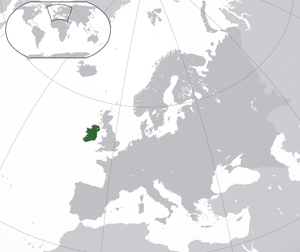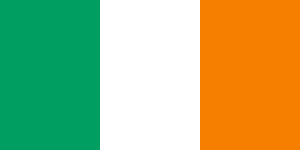Ireland
| Republic of Ireland |
|
(and its largest city) Ulster, Scots, NISL, and Shelta |
Source information is available at [ Sources ] |
Ireland is the third-largest island in Europe. To the east of Ireland, separated by the Irish Sea, is the island of Great Britain. Politically, the Republic of Ireland (also known simply as Ireland) covers five-sixths of the island, with Northern Ireland, part of the United Kingdom, covering the remainder in the northeast.
The island's population is slightly under six million. The official languages are Irish (Gaelic) and English, but English is the predominant language today.
The Irish also emigrated to many other countries. For example, 12% of the American population report Irish ancestry, and Irish Australians form 9% of the Australian population.
History
Gaelic Ireland had emerged by the 1st century AD. The island was Christianised from the 5th century onward. Following the 12th-century Anglo-Norman invasion, England claimed sovereignty. However, English rule did not extend over the whole island until the 16th–17th century Tudor conquest, which led to colonization by settlers from Britain. In the 1690s, a system of Protestant English rule was designed to disadvantage the Catholic majority and Protestant dissenters materially and was extended during the 18th century. Ireland became part of the United Kingdom with the Acts of Union in 1801. A war of independence in the early 20th century was followed by the island's partition, creating the Irish Free State, which became increasingly sovereign over the following decades, and Northern Ireland, which remained a part of the United Kingdom. Northern Ireland saw much civil unrest from the late 1960s until the 1990s. This subsided following a political agreement in 1998. In 1973, the Republic of Ireland joined the European Economic Community while the United Kingdom and Northern Ireland, as part of it, did the same.
Irish culture has significantly influenced other cultures, especially in literature. A strong Indigenous culture exists alongside mainstream Western culture, as expressed through Gaelic games, Irish music, the Irish language, and Irish dance. The island's culture shares many features with Great Britain's, including the English language and sports such as association football, rugby, horse racing, golf, and boxing.
Spanking in Ireland
Spanking has a great tradition in Ireland. The most popular spanking implement s in Ireland were the [[belt], the strap (see Irish school strap), and the cane. Irish boys and girls were often subject to harsh corporal punishment both in the home and at school.
As in all of Europe, spanking children has decreased a lot in Ireland in the 20th century. Still, a particularly high interest in spanking today, as revealed by Google Trends.
In the 20th century, school corporal punishment fell out of fashion and was gradually banned in many countries, a trend that continues until the present day.
As of May 2008, Ireland prohibits corporal punishment in schools.
Irish spanking art
There is no known spanking artist from Ireland so far, and no known spanking magazine. This may be connected to the fact that there is also little pornography that has come out of Ireland.
The following affiliated spanking video producers (under parent company Fullforce Productions) are all based in County Longford.
- The Lazy Maid (F/F, website)
Irish spanking videos
Below is a selection of videos featuring Irish subjects, implements, and performers: Kaytlin Davis, Ivy Ireland, Philip Johnson, Dublin O’Brien, Essie Quinn (a.k.a. Irish Essie), Sinead Tennant, Mary Parker.
- A Painful Prescription for Sinead Tennant (SoundPunishment), photos
- A Simple Sum (Northern Spanking), Dublin O’Brien, photos
- The Art of Spanking (Shadow Lane), strapping with heavy Irish strap, photos
- Carwash (Northern Spanking, 2007), Dublin O’Brien, photos
- The Curse of Mr Lewis 2 - Still Cursed (Northern Spanking), Amelia Jane Rutherford, Irish Halloween costume (photos, more photos)
- Detention Center (A) (Firm Hand Spanking, 2022), Essie Quinn, aka Irish Essie, Zoe Page, detention, photos, part B photos
- Detention Center (C) (Firm Hand Spanking, 2022), brat Essie Quinn in detention (photos, part D photos, part E photos
- Detention Center (F) (Firm Hand Spanking, 2022), Essie Quinn caught with alcohol, photos
- Detention Center (G) (Firm Hand Spanking, 2022), Essie Quinn, tawsing, photos, Part H photos
- Detention Center (M) (Firm Hand Spanking, 2022), Essie Quinn jokari paddle (photos, Part N photos, Part O photos, Part Q photos)
- Detention Center (R) (Firm Hand Spanking, 2022), Essie Quinn, St. Andrew's cross, clothes brush, photos
- Essie Spanked Afterschool (Momma Spankings, 2022), Essie Quinn, photos
- Essie Spanked, Strapped and Caned (Cheerleader Spankings, 2022), Essie Quinn, coach John Osborne, photos
- Essie's Judicial Birching: 36 Strokes (At Home with Miss Iceni), Irish Essie (Quinn), nurse, photos, video preview
- Fancy That! (Northern Spanking, 2005), Dublin O’Brien, James Walker, photos
- The Further Regression of Essie (Spanking Sarah, 2023), Essie Quinn, Sarah Stern, age regression spanking, sailor fuku, braids, photos
- Georgina and the School Secretary (Kane/Top Marks, 2002), Georgina (Elizabeth Simpson) lives to regret mocking Miss Flanagan's (Dublin O’Brien) Irish accent (photos).
- Goldilocks and the Three Bare Bottoms (Northern Spanking, 2005), Dublin O’Brien, photos
- Holy Spanks (Girl Spanks Girl), Clare Fonda as an Irish nun, photos
- Hot Cross Bunnies (Northern Spanking, 2007), Dublin O’Brien, Lucy McLean, Leia Ann Woods, photos
- Humiliating Spanking for Smuggling Contraband (Irish Essie's Clip Store, 2024), Essie Quinn, POV, humiliation, photos
- The Irish School Strap - Detention Room (RealSpankings Institute), Irish school strap, photos
- It Started as a Game (Spanking Sarah), Essie Quinn, Sailor fuku (photos)
- It's All Dutch To Me, Part 1 (Northern Spanking), Paul Kennedy, Dutch-Irish Irelynn Logeen as a failing student, book, photos, photos, photos
- Ivy Ireland 1 (Spanking Glamor, 2023), photos
- Kaytlin Davis Collection (F): Bare Bottom Paddling (Firm Hand Spanking, 2005), Irish actress Kaytlin Davis (photos)
- Kaytlin Davis Collection (K): Paddled on Panties (Firm Hand Spanking, 2006), Irish actress Kaytlin Davis, photos
- Loveday's Tour of British Discipline (Sound Punishment), Dani Loveday endures an Irish ferula, striking the hand, photos
- Lucky Girl - St. Paddles Day Paddle Swats (Assume The Position Studios, 2024), Stevie Rose, photos
- Matron Punishes Essie, Part One: Hand Spanking (At Home with Miss Iceni), Irish Essie (Quinn), nurse, alcohol, photos
- Matron Punishes Essie, Part Two: Caning (At Home with Miss Iceni), Irish Essie, photos
- Matron Punishes Essie, Part Three: Birching (At Home with Miss Iceni), Irish Essie, birching, Eton spanking block, photos, video preview
- Matron Punishes Essie, Part Four: Hand Tawsing (At Home with Miss Iceni), Irish Elsie, striking the hand, photos
- 92 Decibels (Northern Spanking, 2005), Dublin O’Brien, photos
- Nun Spanks Naughty Kiva (Girl Spanks Girl), Clare Fonda as an Irish nun, photos
- Pecking Order (Northern Spanking, 2006), Dublin O’Brien, Lucy McLean, photos
- Poor Little Liar (Girls Boarding School), Irelynn Logeen, corner time (photos, video)
- Pray For My Soul (Spanking Online aka Corrected Catholics from CanedSchoolGirls.com and Strict Spanking)
- Miss Parker as Irish nun Sister Mary, Niki Flynn, Dawn (photos, more photos, video)
- Redemption of the Christian Girl (BritSpank.com/Spanking Online), Maisie Dee at a Christian school in Ireland (photos)
- Reform School - Goldie Rosemont (H) (Firm Hand Spanking, 2010), Irish school strap, kneeling, photos
- Slipper Time For Sinead Tennant (SoundPunishment), ponytail, desk, photos
- Spanked in Uniform (G) (Firm Hand Spanking), Lucy Lauren spanked by Irish horse trainer Philip Johnson, photos
- Spanking 201 - Female Spanks Female Edition (Shadow Lane), Stevie Rose, Irish leather "brat smacker", photos
- St. Patrick's Day Skylar (Amateur Spankings), photos
- St. Patrick's Day Spanking (Spanked Call Girls), cosplay, photos
- St. Patrick's Day Spanking (Spanking Veronica Works), fantasy with Veronica Ricci as a leprechaun, photos
- St. Patrick's Day Spanking from Mom (Girl Spanks Girl), Clare Fonda, Ashley Lane, photos
- Strict Headmaster Delivers a Sound Spanking (Strict English CP), Irish discipline strap, vaulting buck, strapping, photos
- Tales From the Reformatory: 271943 Mathews, C.: Evening Chastisement (SoundPunishment), Irish ferula, photos
- Three Schoolgirls Birched (Sarah Gregory Spanking), Irish Essie, Helen Stephens, birching, photos, video preview
- Three Tails of Woe, Part 2: The Irish Au Pair (Top Marks, reissue: Miss Ambers Vintage Spanking), Dublin O'Brien, Eddie Hart, photos
- The Unfaithful (Mommy Sarah Spanks, 2022), Essie Quinn, Sarah Stern, braids, age regression spanking, photos
- Walker Whacks Her (Northern Spanking, 2004), Dublin O’Brien, photos
See also
Prostitution in Ireland
- Prostitution in Ireland ↗ on Wikipedia
Sources
External links
- More information is available at [ Wikipedia:Ireland ]
Chat rooms • What links here • Copyright info • Contact information • Category:Root

